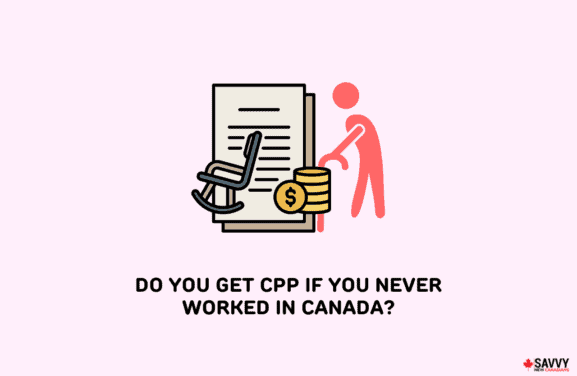The Old Age Security (OAS) pension is one of the main sources of retirement income in Canada.
Unlike the Canada Pension Plan (CPP), which is a plan you contribute to during your working years, the OAS is a direct payment from general government coffers to seniors who meet the eligibility requirements.
Readers of my retirement planning blog often ask me whether the OAS is a taxable benefit, how much taxes they can expect to pay, and the ins and outs of the OAS clawback (i.e. OAS recovery tax).
Is OAS Taxable?
OAS payments are included in your taxable income for the year and taxed based on your income tax bracket.
At the end of the tax year, you will receive a T4A (OAS) tax slip from Service Canada that shows how much OAS pension you received and how much taxes were deducted.
You can typically expect your OAS Statement at the end of February.
The taxable pension amount paid to you is indicated in box 18, and this amount should go into line 113 of your tax return.
If the OAS recovery tax was deducted from your pension, it is also recorded in box 20 of your T4A (OAS) slip. More on this later.
You can request that federal income taxes be withheld each month so you don’t have to pay quarterly or wait until the end of the year to pay a lump sum in taxes.
To make this request, you must complete Form ISP 3520.
OAS pensioners who live abroad pay a monthly 25% withholding tax rate on their benefits when deemed non-residents of Canada.
They may be able to lower this tax rate if their country of residence has a social security agreement with Canada. Here’s a list of countries that have a tax treaty with Canada.
Unless you meet the 20-year residency requirement, your OAS payments stop after you have been outside Canada for longer than 6 months. Payments are restarted after you return to Canada.

OAS Clawback (Recovery Tax)
When your annual income exceeds a certain threshold ($81,761 for the 2022 tax year and July 2023 to June 2024 recovery tax period), you must repay some of your OAS pension.
When your income exceeds $134,626 (age 65 to 74), you are no longer eligible to receive the OAS pension. The threshold increases to $142,428 for the July 2024 to June 2025 recovery tax period.
The default OAS recovery tax (clawback) applied to your OAS pension depends on when you start collecting.
For example, if you start receiving the OAS pension in January 2024, your 2022 income tax return is used to determine how much OAS is clawed back.
However, if you start receiving an OAS pension in July 2024, your 2023 income tax return amount comes into play to determine the impact of the threshold levels for OAS clawback purposes.
The reason for this is that the OAS payment calendar runs from July to June of each year.
The OAS recovery tax is 15 cents (15%) for every dollar exceeding the minimum threshold amount until OAS is totally eliminated.
Let’s dig into the numbers.
OAS Clawback Scenario
- Recovery tax period: July 2023 to June 2024
- Minimum income recovery threshold for 2023: $81,761
- Maximum income recovery threshold for 2023: $134,626 (age 65 to 74)
- Applicable income tax year: based on your 2022 tax return
If your total income in 2022 is $95,000, your repayment amount is calculated as:
- ($95,000 – $81,761) = $13,239
- $13,239 x 0.15% = $1,985.85 in OAS clawback
You will be repaying $1,985.85 for the July 2023 to June 2024 payment period.
This means that roughly $165 (i.e. $1,985.85/12 months) will be subtracted from your monthly OAS payments starting in July 2023. This recovery tax paid is reflected in box 20 of your T4A-OAS.
When your annual income is lower, it may result in excess OAS clawback. In this case, you will receive the excess amount back after filing your taxes.
If you can pre-empt that your income will be lower for next year, you can stop CRA from applying the higher rate OAS recovery tax by completing Form T1213 (OAS).
How To Minimize OAS Clawback
Your total worldwide income is considered when determining OAS clawback (including dividends, capital gains, and interest income).
Some of the strategies to reduce or eliminate the OAS Clawback are:
- Use up your TFSA first. Withdrawals from a TFSA are not taxable.
- Trigger capital gains before age 65 when you start collecting your OAS.
- Maximize all the tax deductions at your disposal, including using up your RRSP contribution room. If you are over age 71 and have contribution room, you can still contribute to a spousal RRSP account if your partner is under 71.
- Delay collecting CPP till later years when your income level is lower.
- Split pension income with a spouse to lower net income for both individuals.
Read more on how to minimize the OAS clawback.
Old Age Security Overview
The OAS is a retirement benefit available to Canadian citizens and residents who are at least 65 years of age and who have lived in Canada for at least 10 years after they turned 18.
Canadians who retire abroad must have lived in Canada for at least 20 years since age 18 to continue receiving the OAS pension.
Seniors can choose to delay taking their OAS until age 70 to increase the benefits they receive. The maximum monthly increase possible is 36% at age 70.
For a bit of historical background on the OAS, the program was initially introduced in 1927 (under the Old Age Pension Act) and was available to retirees aged 70 and older with annual incomes less than $365.
It was expanded in 1952 to provide retirement income of up to $480 per year.
In 1967, the Guaranteed Income Supplement became a part of the OAS pension.
Is GIS Taxable?
The Guaranteed Income Supplement is an additional OAS benefit paid to low-income seniors receiving the OAS.
Unlike the OAS pension, GIS payments are not taxable. The income threshold to qualify for GIS varies depending on whether:
- You are a single, widowed, or divorced pensioner.
- Your spouse receives (or does not receive) the full OAS pension.
- Your spouse receives the allowance.
Below are the GIS amounts for individuals receiving a full OAS pension in the second quarter of 2024 (between April and June).
| Scenarios | Maximum monthly payment | Maximum annual income threshold |
| If you are a single, widowed, or divorced pensioner | $1,065.47 | $21,624 (individual income) |
| If your spouse/common-law partner receives the full OAS pension | $641.35 | $28,560 (combined income) |
| If your spouse/common-law partner does not receive an OAS pension | $1,065.47 | $51,840 (combined income) |
| If your spouse/common-law partner receives the Allowance | $641.35 | $39,984 (combined income) |
Service Canada reviews your eligibility for the GIS program every year, and when your income exceeds the threshold (based on your income tax and benefit return), your payments stop.
GIS payments also stop when you leave Canada for more than six months.
There is a buffer of $5,000 in employment income before there is a GIS clawback.
How To Apply for the OAS
Eligible seniors are automatically enrolled in the OAS and GIS programs. if you do not receive a letter stating you will be enrolled automatically, you can complete Form ISP-3550 and mail it to designated Service Canada offices for your province.
If you have questions regarding your OAS application, contact Service Canada at 1-800-277-9914 (Canada/US) or 1-613-957-1954 (outside Canada/US).
For questions about your taxes, contact the Canada Revenue Agency at 1-800-267-5177 (Canada/US) or 613-952-3741 (all other countries).




Hi Enoch
I lived in Canada for 21 years after I turned 18. I have never worked in Canada and currently collect US Social Security . I left Canada in 1997 , am 71 years old and I live in USA. I was told that I can collect OAS but some be clawed back somehow. Would I have to file Canadian income tax returns each year?
Ed ByRne,
Yes, the amount is pro-rated. Also, there is a treaty between the US and Canada. You are missing on both OAS and supplemental amount from US Social Security.
Arrived here in 1973 and received my old age pension when I turned 65 but suddenly my pension stopped last July last year with no explanation at all.I have been trying to contact but to no avail at this time. Widow now for 2 years and my income was below the threshold income.
Thanks for your reply soon.
Estrella: That’s weird. Your best bet is to contact OAS directly at 1-800-277-9914. They will need to review your account to see what the issues are. Best of luck.
What percentage should I have deducted from my oas
Hi Enoch,
I arrived in Canada in Mid-June 2001 and applied for OAS to begin in January 2021. I was 65 in mid-June 2018 so according to my calculation I should be entitled to 19/40ths. of the current $615.37 maximum plus an 18% uplift for the 30 months I delayed after I turned 65. However, I was only awarded 17/40ths. with an 18% uplift.
The explanation was the the 17/40 of the $615.37 plus the 18% uplift is more than 19/40ths. without the 18% uplift and that in some very rare cases the calculation without the uplift would be more.
Why would they not include the uplift for the full 19 years? They also mentioned something about me not being able to double-dip which I don’t fully understand.
Hi Enoch,
Thanks for the informative article. I’m 59 and an immigrant to Canada. I will only be able to have partial OAS benefit at age 65 since I’ll have lived in Canada for 11 years only by then. I have lived in the US altogether 22 years but Social Security in the States told me their record showed I had 40 quarters in their system. I assume that means 10 years only. So ..
1) When I turned 65, how many years will Canada consider me to have resided in Canada for? 21 years? 11 years or 33 years? What number should they use to calculate my monthly OAS amount?
2) With a partial OAS amount, will my GIS be discounted too?
Thank you.
@Mike. Good questions! I had to look up the partial OAS and GIS payment angle.
1. Can’t say for sure. It will be 11 years for Canada…I am not sure how the US-Canada social security agreement comes to bear (whether combined or paid separately).
2. No. You will likely receive a higher GIS as the benefit amount is based on your overall income (which could be lower resulting in higher GIS than someone who is getting the full OAS). This article may be useful: https://retirehappy.ca/receiving-partial-oas-pension-affects-gis-amounts/
How is the GIS determined total income or net income. Status Indians working on reserve do not have to include the CPP on their tax returns or their retirement pensions if they spent their lives working on Indian Reserve.
@Moses: I believe it is net income.
I understand that both OAS and CPP payments are considered taxable income by the federal government. Do provinces also impose their own separate taxes on OAS and CPP payments? I ask because I’m trying to estimate how much voluntary taxes to withhold from my OAS and CPP benefits upon reaching age 65 in December of this year.
@Chris: Yes, you pay both federal and provincial taxes on OAS/CPP income. The taxes you pay are based on your tax bracket.
https://www.savvynewcanadians.com/federal-provincial-tax-brackets-canada/
The tables that Services Canada put out are confusing. The one under theabove GIS information is misleading. If a person makes 18,774 they will get no GIS. That is the top threshold. The 923.71 is if you make no income from any other sources other than OAS which doesn’t count towards the GIS. People get all excited and think the government is going to give them almost 1000 dollars. It is just not true. I told them what my pensions would be when I quit work. One a municipal pension, the other CPP. They said I could get about 600.00 GIS. GIS is for people that have no income other than the OAS.
In the sample calculation above you seem to have a typo or update error.
Where it shows
($95,000 – $79,054) = $17,420
shouldn’t it say ($95,000 – $79,054) = $15,946 ?
@L Stipelman: Thanks for pointing that out. It is now updated.
I have never had an income at $79,845 to $129,757 which I read is the threshold and yet, they are constantly cutting back my OAS/GIS this last year being 2022 I lived on roughly $600.00 a month. I take medications and so if I wasn’t living with family at that time, it would be impossible to survive. I just received my paper work for tax purposes and completing my income tax and my yearly amount for OAS is $6,542.04 CPP is $979.20 this is total income for the year, its disgusting. So $545.17 + $81.60 = $626.77 a month, how does a person survive on that, I could understand if I had the threshold amount coming in that would make sense, but I don’t and I’m disgusted with our government.
Our total household income from our OAS and CPP pension is way below the threshold of 39,000 per year. Do we still have to deduct tax for that?
Thanks Mr Enoch
@Fraxy: Taxes are payable on OAS and CPP income. That said, after deducting your personal amounts as a couple, your taxes should be minimal if your combined household income is below $39k.